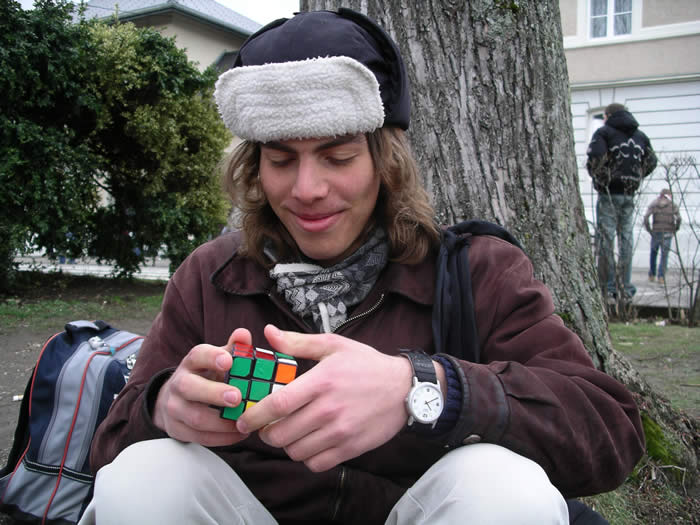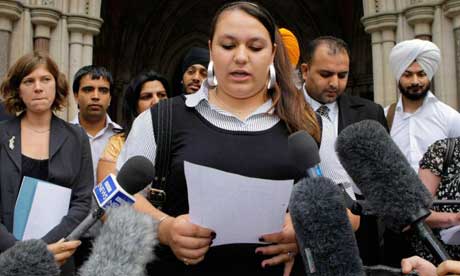
The Sikh Research Institute (SikhRI) reported today that Arpinder Kaur, 28, of San Antonio, Texas has become the first turbaned pilot hired by a commercial airline in the United States. As a Sikhni, she has helped pave the way for both Sikh men and women who wear a dastaar/turban to fulfill their passion for flying. No longer does flying just have to be an extra-curricular activity for these Sikhs, but it can also be an every-day job!
States. As a Sikhni, she has helped pave the way for both Sikh men and women who wear a dastaar/turban to fulfill their passion for flying. No longer does flying just have to be an extra-curricular activity for these Sikhs, but it can also be an every-day job!
In March 2008, after resolving the issue of wearing her dastaar on-the-job, with the help of the Sikh Coalition, Arpinder Kaur was officially hired by American Airlines Corporation (AMR) as a First Officer. She filed her grievance for accommodation of her religious article of faith based on American Airlines’ allowance of “regulation approved hats”. An agreement was reached that is consistent with state and federal anti-discrimination law. In June 2008 she finished her pilot training program and is now flying Embraer Jets for American Eagle, a regional airline that is part of AMR based out of the Dallas-Fort Worth International Airport.
When Arpinder Kaur was asked why she chose to do this, she said:
“Two of the reasons I did this were: first, my love of flying and, second, to set a precedent for the community so they know you can be in your Sikh appearance and do anything out there; so that my younger brothers and sisters [the rising generation] will pursue their passions while practicing their Sikh faith.”
Her passion for flying first started when at the age of 15 she got to sit in the cockpit of an airplane when moving from Panjab. Despite having a degree in Information Systems and her mother’s belief that it was too dangerous for a girl to be a pilot, Kaur has chosen to follow her passion; while using it as a means for supporting her family. Kaur said it was the love and support of her husband, Pritpal Singh that pushed her forward on the path toward becoming a pilot. Kulbir Singh Sandhu, captain with AMR mentored her throughout her aviation career. From 2003 to 2005 Kaur was trained by Jesse Sherwood in Kansas. With the help of these individuals and others along with her own perseverance and determination, Kaur and American Airlines have shown that accommodation and not assimilation is the way to harness the strength of diversity in America.
Harinder Singh, executive director of the Sikh Research Institute (SikhRI) in San Antonio, Texas said, “This is a great day for the Sikhs in America. Religious accommodation, not assimilation, is what the founders of this great nation envisioned and we are thrilled American Airlines celebrates the rich religious and cultural diversity of all American populations.”
Here is a short film on Arpinder Kaur and “piloting”:
Is your mom “chapter president” or a “member” of the local Sikh women’s Sukhmani Sahib club? Many Sikh women (generally those with Auntie status) are commendably coming together to form small groups who go to each other’s homes about once a month to do Sukhmani Sahib da paat to help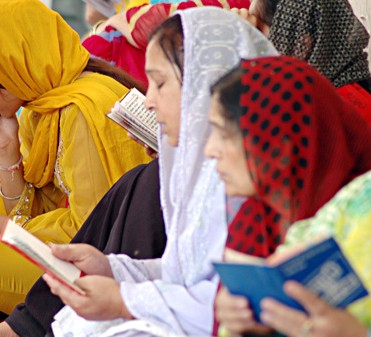 bring/remember peace. Sometimes there is a specific issue a woman’s family is encountering and at other times it just for general familial peace. Thus, our mothers and aunties get to socialize about their everyday lives and connect spiritually through sangat and paat! One of the many things we could learn from them about practicing Sikhi!
bring/remember peace. Sometimes there is a specific issue a woman’s family is encountering and at other times it just for general familial peace. Thus, our mothers and aunties get to socialize about their everyday lives and connect spiritually through sangat and paat! One of the many things we could learn from them about practicing Sikhi!
As International Day of Peace approaches on September 21st, these groups of Sikh women are being asked to come together to recite Sukhmani Sahib da paat. Sukhmani can be defined as counselor of peace or peace of mind with sukh meaning “peace” and mani meaning “mind”, “heart” or “jewel”. The entire paat/poem is known as the “jewel of peace” or “song of peace”. So if your mom belongs to one of these groups or is interested in joining/creating one, please let her know about this day of observance! Now she can do paat to help bring/remember peace in the world along with your well-being!
p.s. It’s always interesting about how many Sikh women are the focal points for spirituality in homes … but that’s another post! 
Everyone seems to be searching for it online. The Langar Hall got it first. So, for those of you that missed the opening ceremonies of the Olympics, here is a picture of the Punjabi Sikh field hockey players on the 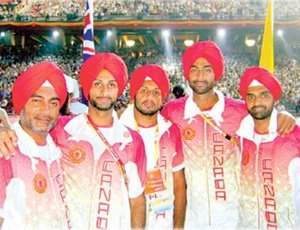 Canadian field hockey team with their pagris (turbans). Pictured from left to right: Assistant Coach Nick Sandhu, Bindi Kullar, Sukhwinder Gabbar Singh, Ravi Kahlon, and Ranjeev Deol.
Canadian field hockey team with their pagris (turbans). Pictured from left to right: Assistant Coach Nick Sandhu, Bindi Kullar, Sukhwinder Gabbar Singh, Ravi Kahlon, and Ranjeev Deol.
For previous coverage of the Canadian Field Hockey Team on The Langar Hall see:
Canadian Field Hockey – individual biographies
Sikhs in the Olympics, Beijing 2008 – for a discussion of their turban-wearing decision
Recent Results:
The team lost their first game against the #1 ranked Australians. They will be playing Pakistan next on Day 5 (Wednesday) at 6am EST. Pakistan lost their first match to Great Britain.
We’ve occasionally, briefly discussed the current French ban in public schools on articles of faith. Recently, the Sikh Coalition invited high school students from all over the world to submit entries into their Diversity Essay Contest on “The Role of Freedom of Religion in the context of Contemporary Society.”
Students were asked to take one of the following two sides on the French Parliament’s ban on conspicuous “religious” articles of faith from public schools:
- If you favor the ban: While engaging with issues faced by communities impacted by the ban, please discuss how France’s conception of secularism (laïcité) can be used to shed light on the ban.
If you oppose the ban: What makes you oppose it? Please outline a strategy through which the international community may be mobilized to force France to repeal the ban.[link]
The first place winner was Casey Friedman, from Alameda, CA whose essay can be viewed here. An excerpt from this winning essay:
“Although Article 10 of the high-minded Declaration of the Rights of Man and the Citizen states explicitly, “No one should be disturbed on account of his opinions, even religious,” and although the Constitution of the Fifth French Republic recognizes the Déclaration as fundamental law (“La Déclaration”), France today finds itself uncomfortably pulled in every possible direction by the forces of religion, popular will, secularism, and natural right.” [link]
This competition seems like a great way to engage youth both in and outside our community in a conversation on freedom of religion.
In light of the recent post on Punjabi classes in California high schools, I ran into this article in the Chronicle Herald about Sikh summer school:
A couple of years ago Aman Tut’s seven-year-old daughter asked her if she could wear a Christian cross. Tut was surprised because she and her husband are Sikhs… So they enrolled their girls in summer school at the Golden Triangle Sikh Association temple near Petersburg, just west of Kitchener.
The Tut family works weekends and isn’t able to attend the weekly Sunday services and school programs at their gurdwara. The local gurdwaras have come up with a really interesting model to augment their typical “Sunday school” courses.
Four years ago, organizers started a weekday program that runs from 4 p.m. to about 9 p.m. each day. Unlike most vacation Bible school programs that run for a week or two at many churches, kids attend the Sikh program from early July to the end of August… At the beginning of each class, about a dozen students take music lessons on instruments that are used during Sikh worship services. The boys learn to beat rhythms on tabla drums, and girls are taught the basics of the harmonium, an instrument resembling both a tabletop organ and an accordion. By 5 p.m. the majority of students have arrived for classes in Punjabi language, Sikh history and religion.
I don’t know if, as an adult, I would be able to make it to a class every day, but I really liked how the organization had set up their summer school classes, and I wonder if it could be extended or expanded into a “night classes” model for adults during the rest of the year, as well. It seems like a really helpful and interesting alternative to Sikh youth camps, which are often too short or lack enough context to help kids build long-term knowledge and skills. It also has the added benefit of being close to parents who may be concerned about sending their kids away but still want them to benefit from a religious education. What do you think, readers? Between high school programs and night courses, what model of instruction (and time commitment) would work for you, individually, and possibly for your child?
 Abhinav Bindra was considered a child prodigy, but has had limited success on the largest competitive stages. Still he is considered a medal hopeful.
Abhinav Bindra was considered a child prodigy, but has had limited success on the largest competitive stages. Still he is considered a medal hopeful.
Bindra will be competing in the 10m air rifle competition. Qualifications and the finale will all be on Day 3 (Monday, August 11, 2008) in the afternoon
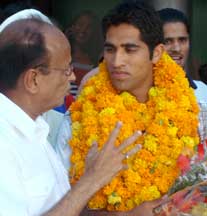 Rowing
Rowing
Manjeet Singh, a Chandigarh rower, has had much success at the junior levels. He will be competing in at the world stage in Beijing in the lightweight double sculls event. While Manjeet Singh and his partner Devinder Kumar are not considered medal contenders, they are hoping for a top-10 finish.
Rowing is set to begin on Day 1 (Saturday, August 9, 2008) at 17:00-17:10.
Representing the world of weightlifting, 5’3” Jasveer Singh (sometimes written Jasvir Singh), who came from Punjab in 2002, has become a Canadian and Sikh sensation (many communities have even held akhand 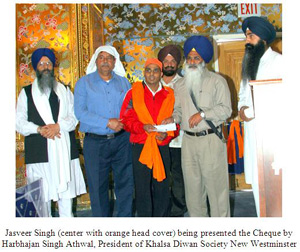 paaths to raise money for him). He is the first British Columbian weightlifter to go to the Olympics in twenty years. Jasveer (Jasvir) Singh has been sponsored by many Sikh groups including the Khalsa Diwan Society New Westminster in hopes of bringing Olympic glory to Canada. On the right you can see Jasveer Singh being honored and given a check by members of the Westminster Sangat.
paaths to raise money for him). He is the first British Columbian weightlifter to go to the Olympics in twenty years. Jasveer (Jasvir) Singh has been sponsored by many Sikh groups including the Khalsa Diwan Society New Westminster in hopes of bringing Olympic glory to Canada. On the right you can see Jasveer Singh being honored and given a check by members of the Westminster Sangat.
Jasveer Singh will be competing in the Men’s 62kg category. According to the official Beijing 2008 Olympics schedule, the event and the medaling ceremony will all be on Day 3 of the Olympics (Monday August 11, 2008).
So today will mark the opening of the Olympic Games. Some will cheer for their states; some will cheer for their heroes; some won’t care.
Well, here are FOURTEEN reasons to care: reasons that transcends national barriers and in many ways is more reflective of our Sikh-centered, globalized outlook. It is related to the fact that Sikhs from throughout the world congregate here at The Langar Hall and that issues ranging from Kenya, New Zealand, Canada, Panjab, England etc. all interest us
So in this spirit of continuing to foster a globalized Sikh diasporic community, I present to you the untold story of Punjabi Sikhs in the Olympics. The reason I am using the term ‘Punjabi Sikh’ is because I don’t really know how they identify themselves, but their names indicate that they come from a common ethnic stock – a Punjabi Sikh background.
I am trying to make this list comprehensive, so if I left anyone out, please feel free to post a comment and I will go back to add them. Let’s make this a project we do together, by posting their finishings and results. [also thank you to Mandeep Singh for correcting some of my mistakes]
Sikhs in the Olympics:
Sikhs are one of those great unknown Olympic stories. It is a diasporic story where Sikhs have representeed many countries and many continents. In the Beijing Olympics, there will be Sikhs (on as far as I could figure out using the wikipedia lists) coming from India and Canada. In years past, Sikhs have been included on teams from Kenya, Great Britain, and even Malaysia. From the regions of the five Olympic Rings (Blue – Europe, Yellow – Asia, Black – Africa, Green – Oceania, Red – Americas), Sikhs, including those in the diaspora have been at the center of many Gold medal winning teams – especially in field hockey. As far as individual glory, Milkha Singh “the Flying Sikh” disappointing fourth place finish in the Men’s 400M in the 1960 Rome Olympics.
In a recent post, Camille asked important questions around growing Sikh female leadership/representation, rather than just “managing” it. At the heart of leadership in any organization is decision-making. A critical component of growing Sikh female-leadership/representation is giving access to decision-making spaces that are commonly occupied by Sikh men and incorporating female perspectives into decision-making. Thus, you will see the strongest battles for gender equity in Sikh organizations tend to be fought around decision-making power. A recent example of such a battle was at a Gurdwara in Bristol, U.K. where two factions were fighting over allowing women to take part in Gurdwara elections. Women were demanding the right to vote while also running for committee-member seats. This past Sunday during Gurdwara management-committee elections, both factions broke out into a riot over allowing 79 women to vote past the registration deadline.
According to the Daily Mail:
Six riot vans were dispatched to close the road in Fishponds, Bristol, and one man was arrested and cautioned for a public order offence during the seven-hour stand-off.
Voting finally finished at 4pm and resulted in three women being voted onto the management committee for the first time in the temple’s history.
The trigger for the riot was when one man frustrated by the situation started trouble inside the Gurdwara that spilled out onto the street where “women were blocking his car and trying to push it over while he was still inside clinging to the steering wheel”.
An elderly women at the site reported “… a crowd of mainly women and children stood on one side of the road and men on the other. They were fronting each other up and shouting abuse across the road. The women were screaming ‘we’re not going anywhere’.
I recently ran across Relocating Gender in Sikh History by Doris R. Jakobsh who is now an Assistant Professor of Religion at the University of Waterloo. I’m not a scholar of either Sikh history (and Jakobsh shouldn’t be considered one until she can read and understand Gurbani), and the ideas presented below are just fodder for discussion – not being put forth as any authoritative data.
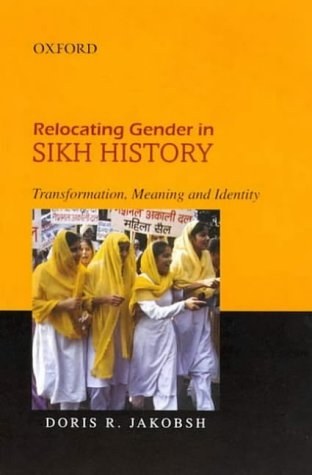 The framework she uses notes the difference between the prescribed Sikh belief of equality amongst Sikh women and men, and what is actually practiced within the Sikh community, claiming that gender has generally been dealt with in 1 of 4 ways: silence, negation, accommodation, idealization.
The framework she uses notes the difference between the prescribed Sikh belief of equality amongst Sikh women and men, and what is actually practiced within the Sikh community, claiming that gender has generally been dealt with in 1 of 4 ways: silence, negation, accommodation, idealization.
One of the biggest problems that I noted when reading the book is her use of English translations of Gurbani for her basis of analysis. We’ve discussed before the problems that we, as Sikh practitioners, experience in understanding Gurbani, due to language barriers. Yet, she bases her research on translations that are subject to the same barriers and misunderstandings. Because of this language barrier, her reading of Gurbani is way off. Despite this, I do believe her feminist analysis of historical writing warrants discussion.
1- Silence: Jakobsh claims that silence is the guiding principle regarding women in Sikh history. Traditional recording of history focuses on politics and economics, realms that women have not been well represented. Women have also not been the authors of their own history, and so the specific questions asked have been those of interest to male historians.
Sarika Watkins-Singh won her case in South Wales this week. The news was in many newspapers, including The Guardian, which is normally well researched. Considering the high standard of journalism that its reporters are normally held to, it’s surprising that the following statement was made so off-handedly, in a story about Sarika’s case.
Mr Justice Stephen Silber concluded the school was guilty of indirect discrimination under race relations – Sikhs are a race – and equality laws. [link]
Um, we are?! Last I heard, Sikhi was a religion. How does a religion become a race? Where did this author get this idea from?
The only remotely related idea that this statement could come from stems from the antiquated idea that Sikhs are a martial race. But even wikipedia makes clear that this idea is no longer acceptable.
Martial Race or Martial Races Theory is an ideology based on the assumption that certain ethnic groups are inherently more martially inclined than others. It was a term originally used by the British, who observed that the Scottish Highlanders were more fierce in battle than others in the British Isles, and extended this concept to India, where they classified each ethnic group into one of two categories: ‘Martial’ and ‘Non-Martial’. A ‘martial race’ was typically considered brave and well-built for fighting but was also described as ‘unintelligent’. The ‘non-martial races’ were those whom the British believed to be unfit for battle because of their sedentary lifestyles. Of late, this concept has been dismissed as Imperialistic and based on racial stereotypes. [link]
We’re continuing our coverage on Snoop Dogg in Bollywood. And now, we’re joined by the New York Times. Some may grimace at the thought of Snoop promoting Sikhs, but he’s definitely bringing us a LOT of exposure these days. 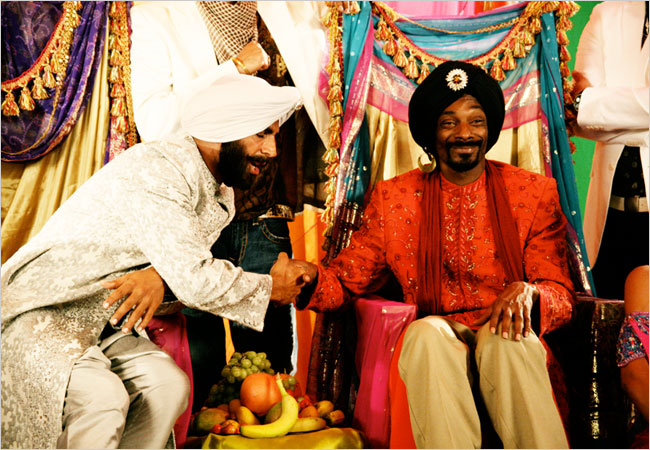
Snoop Dogg wears a Sikh turban and an ornate long coat called a sherwani in a video of the title song, which was shot this year in Chicago… “I really dig how much music is infused with the movies” in Bollywood, Snoop Dogg said in an e-mailed response to questions. “Lots of hip-hop tracks sample Indian music, and a lot of their music sounds like it was influenced by hip-hop,” he said. “We’re putting together something real big” in India, that will include collaborations, live shows and “more movies with some of my Bollywood homies.” [link]
Mewa Singh predicted that Snoop’s collaborative song with Bollywood would become the hottest new track with bhangra teams and Punjabis in the diaspora. It’s already taking over the airwaves in India, which is sort of a break through since hip hop has only been popular amongst the young, urban crowd there until now.
“I’m coming to take over Bollywood,” Snoop Dogg promised during the video shoot. “I’ve never been able to come over there and do shows for you all, but now I’m going to come and do shows,” he said in a clip that the video’s promoters put on YouTube. “This is just the beginning.” [link]
Ever wondered what Snoop thinks of you?
When I was an undergraduate, I had the opportunity to attend the World Sikh Council – North America Region‘s conference on Women in Sikhi. The conference hosted panelists and speakers to discuss three broad categories: the depiction of women in Scripture (SGGS Ji), the treatment of women in the Rehit Maryada, and future possibilities/actions for promoting gender equity. The WSC, like many Sikh institutions, was heavily male-dominated at the time, although the conference liaisons did an admirable job trying to recruit a diverse panel of women to organize, speak, and develop the program. Nonetheless, the majority of conference attendees (until the very last panel) identified as men, and there was no conversation around the agency of men as allies in the struggle for gender equity. It’s always easier to criticize than construct, and I do think the conference was an important initial step; the organizers’ hearts were in the right place, and they were certainly attempting to place women at the center of the conversation.
What I found most distressing, however, was the deep level at which the “proper role” of women in Sikhi was gendered. In emphasizing the valuation of women, most speakers and commenters focused on the following passage from SGGS Ji (p. 473):
Woman becomes his friend; through woman, the future generations come.
When his woman dies, he seeks another woman; to woman he is bound.
So why call her bad? From her, kings are born.
From woman, woman is born; without woman, there would be no one at all.
Instead of focusing on the deeper meaning of this passage — that woman is a unique and necessary partner in the faith and in humanity –, most speakers placed the significance of women solely in the context of motherhood. As a result, the impact of women’s leadership is often reduced to a single meme: woman as cultural vessel — the bearer of children (Mata) and imparter of religious knowledge and instruction. This highly gendered role and image severely limits how we conceive of the role of women, both as public figures and speakers, but also in terms of their “value-added” to society.
All the headlines are centered on the news of the capture of Bosnian Serb wartime president, Radovan Karadzic. Karadzic has been indicted for genocide in the Bosnia war. Apprehended by government officials, a change in political winds in Serbia now-seeking EU membership has allowed for the present Serbian government to capture the thirteen-year fugitive. The world is now waiting for Karadzic to be transferred to The Hague to  face trial.
face trial.
Karadzic’s soon-expected extradition and last week’s International Criminal Court (ICC) prosecutor request that genocide charges should be brought against Sudanese President Omar al-Bashir for state-sponsored pogroms in the Darfur region of Sudan is being watched the world over.
Karadzic’s arrest led to one Munira Subasic, head of a Srebrenica widow’s association (for more information on the Srebrenica Genocide/Massacre, click here), stated
“[Karadzic’s arrest] is confirmation that every criminal will eventually face justice.” [link]
I hope Subasic’s comments ring true. While I celebrate the capture of one tyrant, as a Sikh, my attention wanders (as it tends to) to the situation in Punjab and the Indian State.
What is American religious tradition and how does it influence the practice of Sikhi in the US?
Recently, the Pew Forum on Religion and Public Life surveyed nearly 36,000 people of various religions (including no affiliation/atheists) with questions about their religious beliefs. Questions addressed whether individuals believed in a literal interpretation of scripture, the strength of adherents’ belief in God or universal spirit, views of one’s religion as the one true faith, as well as social and political beliefs. More information and results of the survey can be found here.
Some think the findings expose a superficiality in the practice of faiths in the US.
“Religion in America is 3,000 miles wide, but it’s only 3 inches deep,” said Professor D. Michael Lindsay, a sociologist and religion demographer at Rice University. “The issue is not that Americans don’t believe in anything. It’s that they believe in practically everything. It’s possible for Americans to hold together contradictory beliefs at the same time.” The survey found that there are Catholics who meditate, while Lindsay said other surveys have found Protestants who pray to the Virgin Mary. [link]
 One might question this conclusion that because a person holds contradictory beliefs, it means they only superficially understand/practice their religion. It may just mean that people are trying to reconcile science, their experiences, or contradictory moral beliefs with specific tenets of their own religion. The fact that they continue to hold the belief that religion proposes despite contradictory experience or scientific finding shows faith, and in my opinion, commitment.
One might question this conclusion that because a person holds contradictory beliefs, it means they only superficially understand/practice their religion. It may just mean that people are trying to reconcile science, their experiences, or contradictory moral beliefs with specific tenets of their own religion. The fact that they continue to hold the belief that religion proposes despite contradictory experience or scientific finding shows faith, and in my opinion, commitment.
A recent French decision brings debates about multiculturalism and accommodation back into focus. France’s highest administrative court prevented the wife of a French national and mother of 3 French- born children from obtaining French citizenship based purely on her wearing of a niqab– for “insufficient assimilation” into France:
…last month, France’s highest administrative court upheld a decision to deny citizenship to Ms. Silmi, 32, on the ground that her “radical” practice of Islam was incompatible with French values like equality of the sexes. [link]
The decision received support from some French-Muslim officials who do not support women’s wearing of niqabs.
niqabs.
The ruling on Ms. Silmi has received almost unequivocal support across the political spectrum, including among many Muslims. Fadela Amara, the French minister for urban affairs, called Ms. Silmi’s niqab “a prison” and a “straitjacket.” “It is not a religious insignia but the insignia of a totalitarian political project that promotes inequality between the sexes and is totally lacking in democracy,” Ms. Amara, herself a practicing Muslim of Algerian descent, told the newspaper Le Parisien in an interview published Wednesday. [link]
There are major differences between the niqab and Sikh religious dress. The objection to the niqab that it’s incompatible with the French value of equality of the sexes doesn’t carry over to Sikh dress. The dastaar or pag doesn’t pose the same dilemma as both men and women may wear it, and it is not seen as an inhibition on gender equality generally.
Guest Blogged by Mewa Singh.
A bit late, but every bit warranted.
Let me begin. I am a HUGE Rabbi Shergill fan. I went to a Dharmendra/Sunny Deol “concert” two years ago (why they are called ‘concerts’ I have no clue) and Rabbi Shergill was performing. I think I was the ONLY 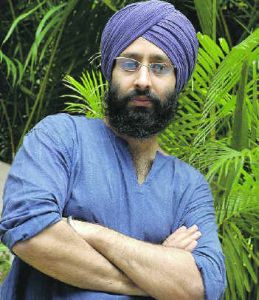 Rabbi Shergill fan in the audience and in certain parts of California that isn’t too surprising. Although my friends and family made fun of me, they were kind compared to the rest of the audience. The audience yelled their ever-so-kind “Eh ki bakwas hai? Bhangra Ga!” (What is this crap? Sing Bhangra!) and began to boo him off the stage in the middle of his ‘Chhalla’ performance. Although I love my hometown, sometimes we are stupid.
Rabbi Shergill fan in the audience and in certain parts of California that isn’t too surprising. Although my friends and family made fun of me, they were kind compared to the rest of the audience. The audience yelled their ever-so-kind “Eh ki bakwas hai? Bhangra Ga!” (What is this crap? Sing Bhangra!) and began to boo him off the stage in the middle of his ‘Chhalla’ performance. Although I love my hometown, sometimes we are stupid.
Rabbi’s first self-titled album played in my car for months straight. Despite the ridicule of all of my friends, I was mesmerized by his brilliance. In my own version of ‘elitism,’ I just thought they couldn’t “understand” Rabbi. How brilliant was this contemporary music artist not only recreating but reinterpreting classic poetic metrics and musical composition forms with current political and social content. While his “Bulla Ke Jana” garnered critical attention and success, for me his “Jugni” with its political content, “Totia Manmotia” for its social charge and reinterpretation of a whimsical Mughal-period popular dialogue between parrots, and the thrilling rendering of his Shiv Kumar Batalvi in “Ishtihar” sent tingles down one’s spine. Sepia Mutiny’s Amardeep criticized Rabbi’s earlier supposed “Sufi/Sikh spiritualist” image, however, such a reading could only be made by one that had never listened past “Bulla Ke Jana.”
Although three years in the making, Rabbi returns with a new album Avengi Ja Nahin (the website includes song samples, videos, and even lyrics). The album has 9 tracks and I have yet to listen to all of them. The cover song “Avengi Ja Nahin” is a nice love song. The other song to gain much attention is his “Biqlis” that provides a voice to the many voices lost during the anti-Muslim government-sponsored pogroms in Gujarat in 2002. The song is stirring, being both patriotic but critical.
Punjabis can argue whether Gurdas Mann’s classic Chhalla from the movie Laung Da Lishkara is the best or Rabbi’s new rendering. For my vote, I just want to add that Rabbi is on the world stage singing Punjabi (in his Jugni invoking that the solution to today’s problems was to invoke the Guru’s name), while during the 1980s and early 1990s Gurdas Mann went to Bombay and record plenty of Hindi content.
However, especially important for a Sikh audience would be a discussion on his song “Pagri Sambhaal Jatta.”
Over the past few years the website Sikhitothemax.com has become one of the premier tools for English-fluent Sikh youth to access their Guru Granth Sahib. While STTM has problems that can be addressed at another time, it is important to realize the effect that this tool has had. 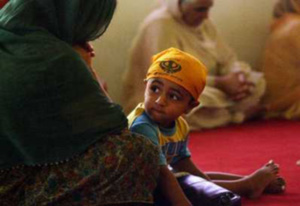 Many Gurdwaras throughout the world have added STTM translations as part of their regular programs and the projection system in the Gurdwara is fast becoming the norm.
Many Gurdwaras throughout the world have added STTM translations as part of their regular programs and the projection system in the Gurdwara is fast becoming the norm.
But is it enough?
In a recent article in the Fresno Bee, reporter Vanessa Colon looks at the question of “losing tradition in translation.”
Colon interviews a number of Central Valley Sikhs and finds that the Sikh youth are often not engaged with their Gurdwara. Although there a number of reasons, she delves into the question of language first and foremost. Some local Fresno Sikhs blamed the Sikh youth for not learning enough Punjabi. However, I see that this approach has problematic for there are now a number of Punjabi/Khalsa schools in California and beyond. However, instruction one day a week for an hour will not ever provide a sufficient language base for one to understand Gurbani.
Earlier in the month, an East Panjabi newspaper editor, Baljit Brar, posed the possibility that Pakistan stood to earn up to $500 million per year by promoting Sikh tourism.
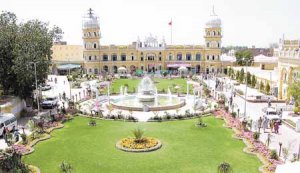 Brar suggests that since the airport in Lahore is more convenient and is better maintained than that in Amritsar, with better border mobility the Lahore airport could be the airport of choice for diasporic Sikhs. Many Sikhs have bought into the ‘Romance that is Panjabiyat,’ including at-times the present langa(w)r-iter. While Brar’s numbers may be grossly optimistic, I do believe that many Sikhs would love to take advantage of new tourism and travel opportunities.
Brar suggests that since the airport in Lahore is more convenient and is better maintained than that in Amritsar, with better border mobility the Lahore airport could be the airport of choice for diasporic Sikhs. Many Sikhs have bought into the ‘Romance that is Panjabiyat,’ including at-times the present langa(w)r-iter. While Brar’s numbers may be grossly optimistic, I do believe that many Sikhs would love to take advantage of new tourism and travel opportunities.
Many Sikhs left West Panjabi villages and cities in their stead in 1947. Another langa(w)r-iter had commented on the traumas of Partition. The opportunity to revisit one ancestral home may be part of the process in healing old wounds.
Brar makes a number of suggestions. In a world where economics flows across borders, new opportunities may avail themselves to the Sikhs to increase the prosperity of Panjab. One hopes governments can help create an environment where greater flows are possible. I definitely have longed to visit West Panjab. What about you? Is something like this feasible?

